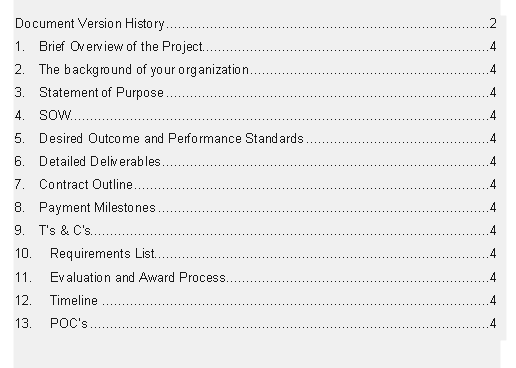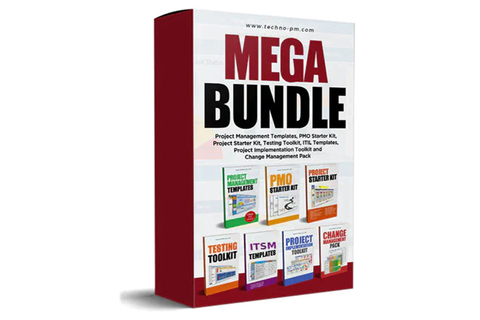Ultimate RFP Process | Steps, Guidelines & RFP Template
Request for Proposal
An RFP (Request for Proposal) is a document which is aimed at soliciting proposals from various vendors, to submit business proposals for a product or service which is required by a company or agency.

The proposal varies in depth and detail, depending on the innovation of the product / service. The RFP is made through a bidding process, where the aim is to receive the product / service at the highest quality with the lowest price.
RFP Template
1. Brief Overview of the Project
This section is aimed at giving the vendor a general idea of what the projects’ goal is.
2. The background of your organization
This section should give the vendor information regarding what the organizations’ field of expertise is, its strengths and weaknesses and business statistics.
3. Statement of Purpose
This section should describe to the vendor what is required in terms of a product or service, as well as the overall objectives that are required from the vendor. Usually this is intended for the supply chain of the vendor.
4. SOW
This section should describe in detail what the expected outcome is, and a detailed list of responsibilities of the vendor. This is usually intended for the technical expert of the vendor, and is more technical in nature.
5. Desired Outcome and Performance Standards
In this section the quality standards need to be specifically outlined and explained in detail. They will determine whether the final outcome meets the standards, and how it will be measured and monitored. This section can also mention what the corrective measures will be, in case the standards don’t meet the specifications.
6. Detailed Deliverables
This section will include a list of all the reports, timelines and most importantly the products that will be delivered during the course of the project. All of these need to include deadlines for delivery.
7. Contract Outline
This section needs to outline the needed start and end dates of the contract, and may also include renewal terms.
8. Payment Milestones
This section explains what the payment conditions are, in terms of expected quality per deliverable. It should also outline what the incentive baselines are for superior performance and what the penalties for inadequate performance or lack of compliance are.
9. T’s & C’s
The T’s & C’s (Terms & Conditions) section is usually a standard paragraph which sets the standard for the required forms of the contracts, certifications and assurances. It could also include any specific requirements that are relevant to the specific contract. This section is usually under the responsibility of the legal division.
10. Requirements List
This section outlines the structure of the forms, timelines and all other documents that will be submitted by the vendor. Since the company wants to compare the different proposals, it is most convenient to compare them side to side. This is easily done if all of them are identical in structure.

11. Evaluation and Award Process
This section fully discloses the procedures and criteria which will be used to evaluate the submitted proposals. It outlines which weight will be given to the main components, such as timeline (30%), cost (25%), technical ability (20%), etc.
12. Timeline
This section clearly outlines the timeline for each step in the submittal process. For example the deadline for submitting clarifying questions, submitting the technical outline, submitting the final proposal, etc.
13. POC’s
This section names the POC’s (Points of contact) for the submittal process, and their means of communications (Business phone number, E-mail address, etc.). Also it lists their title and field of responsibility. For example the lead Engineer is Akshat Patel (Apatel@example.com) and his phone number is +91-45-334-5569.
RFP Process
- RFP info gathering:
the SC (Supply Chain) understands the requirements of the product / service from the project (the PM, COO, Engineering, etc.), and begins writing the RFP according to the template explained above.
- Identify intended audience:
after putting together a final draft of the RFP, the SC needs to identify which vendors are capable of delivering the product / service.
- Approve RFP draft (decision):
The PM reviews and approves the draft that will be sent out to the potential vendors. Specifically they need to approve the technical requirements, deliverable and timeline. If it isn’t approved then the draft returns to step #1 for re-drafting.
- Align draft to legal standards:
the legal team need to review the draft and make sure that it is according to the legal standards and that the company is covered from a legal contractual standpoint.
- Allocate funds:
The finance division needs to approve the budget stated in the RFP, and allocate sufficient funds.
- Approve distribution (decision):
the CEO (Chief Executive Officer) or key stakeholder of the project approve distributing the RFP to the vendors. If the distribution isn’t approved, it returns to step #1 for re-drafting.
- Distribute RFP:
The buyer from the SC distributes the RFP to the vendors.
- Conduct initial filtering:
The buyer conducts the initial filtering of the vendors, leaving only those who meet the minimal standards of the RFP.
- Agree on short list:
The PM (along with their top-team) review the list of vendors approved by the SC, and choose the top 3-5 vendors.
- Perform due diligence:
The legal team check the vendors on the short list, to make sure that they are who they say they are.
- Re-distribute for best and final offer:
The buyer contacts the vendors on the short list, and apprises them that they made the first cut. They then give them an opportunity to improve their quote. The buyer can also share with them where their quote stands in comparison with the other vendors. For example: your quote is second best out of five.
- Recommend bid winner:
After the best and final offer was returned, the PM makes their recommendation of the chosen bid.
- Approve funds (decision):
The finance division needs to allocate the appropriate funds to pay the vendor. If there aren’t sufficient funds, the PM can choose a vendor with a lower quote, or stop the process completely.
- Approve winning bid (decision):
The CEO or key stakeholder approve the bid, if appropriate funds exist. If the bid isn’t approved, the PM needs to choose another vendor or stop the process completely.
- Sign contract with the vendor:
the legal team officially signs the contract with the winning vendor.
- Monitor vendors’ progress:
The PM and team monitor the progress of the product / service to make sure that it is as agreed, covering all aspects.




